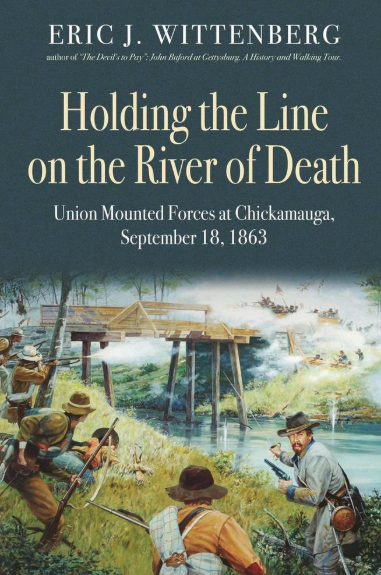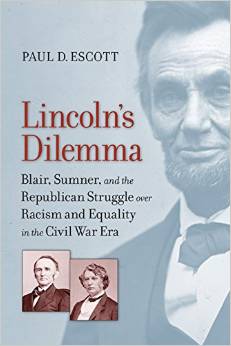Holding the Line on the River of Death: Union Mounted Forces at Chickamauga, September 18, 1863 by Eric J. Wittenberg. Savas Beatie, 2018. Cloth, IBSN: 978-1611214307. $29.95.
 Eric J. Wittenberg’s Holding the Line on the River of Death examines two cavalry actions on September 18, 1863, what he calls the first day of the battle of Chickamauga. Wittenberg asserts that the delaying actions by Robert H. G. Minty’s cavalry at Reed’s Bridge and John T. Wilder’s Lightning Brigade of mounted infantry at Alexander’s Bridge were critical to the battle’s outcome. Had they not slowed the Confederate advance, Braxton Bragg may have severely damaged or trapped William Rosecrans’ army, making Chickamauga far more disastrous to the Union cause.
Eric J. Wittenberg’s Holding the Line on the River of Death examines two cavalry actions on September 18, 1863, what he calls the first day of the battle of Chickamauga. Wittenberg asserts that the delaying actions by Robert H. G. Minty’s cavalry at Reed’s Bridge and John T. Wilder’s Lightning Brigade of mounted infantry at Alexander’s Bridge were critical to the battle’s outcome. Had they not slowed the Confederate advance, Braxton Bragg may have severely damaged or trapped William Rosecrans’ army, making Chickamauga far more disastrous to the Union cause.
Meant to complement The Devil’s to Pay, his work on John Buford at Gettysburg, Wittenberg draws parallels between Minty and Wilder’s actions and those of July 1, 1863. Much like Buford, both men sought to force the Confederates to deploy, slowing their advance and giving Union command enough time to prepare for the coming assault. He notes several key differences from Buford, including their dramatically inferior numbers. Also unlike Buford, both Minty and Wilder lived well after the battle was over, and it is their accounts of the day’s action that form the basis for the narrative that follows.
Wittenberg does not spare praise for Union leadership on the field. He describes the action as “textbook,” and then provides the textbook (Antoine De Brack’s Vidette and Outpost Duty manual) as an appendix. In addition to demonstrating Minty and Wilder’s tactical acumen, Wittenberg uses these excerpts to estimate probable picket locations on the battlefield. Union advantages of terrain and weaponry complemented these tactical actions. The steep banks of Chickamauga Creek formed natural chokepoints at the bridges, funneling superior Confederate numbers into tight areas, while Minty’s revolvers and breechloading carbines, and Wilder’s Spencer repeating rifles further amplified their numbers. Because of the cavalry’s delaying actions, Bragg’s main assault lost its strength—crossing the creek in mid-afternoon, rather than morning as originally planned. A dusk assault across the La Fayette Road met prepared infantry, stopping the Confederate advance and setting the stage for the rest of the battle. Bragg was in front of the Union army, rather than between Rosecrans and Chattanooga as he planned.
In addition to highlighting the good cavalry work performed at Chickamauga, Wittenberg also showcases the difficulties of command on the Civil War battlefield. The detailed accounts allow Wittenberg to emphasize timing: both when events took place and when commanders learned of those events. Confederate leadership comes under particular scrutiny, as the author highlights miscommunication, poor decision making, and missed opportunities that aided Union defenses. Both cavalry brigades were substantially outnumbered, yet held on as Confederate infantry delayed and searched for other avenues of advance. Confederate command regularly misjudged the strength and composition of Union forces in front of them, which led Bragg to believe his plan had been successful by day’s end. Bragg, Bushrod Johnson, Simon Buckner, and Nathan Bedford Forrest all made errors during the attack that prevented Bragg’s ultimate design from coming to fruition.
Wittenberg’s conclusion notes how both Minty and Wilder remained active in commemoration at the Chickamauga battlefield. Even though the book focuses on September 18, the author mentions the ways the two men helped shape the battle’s narrative and shows how their accounts best reflect the day’s events. Wittenberg is particularly critical of Braxton Bragg’s reports as not giving the Union cavalry its proper due. While his report does mention the cavalry actions, he blames bad roads for the Confederates’ delays.
The book’s appendices are all useful additions. Wittenberg includes an order of battle for actions at both bridges, which helps one to visualize the large disparity in numbers (3,200 Union horsemen held off 17,000 Confederate infantry), and the excerpts from Vidette and Outpost Duty. The book also includes a self-directed driving tour that showcases different areas of the cavalry battles (some of which are beyond the National Park Service boundaries), allowing visitors to examine these lesser-known areas.
A brisk read, Wittenberg spares little detail for one day of action—speculating where necessary, but otherwise filling his narrative with accounts from both Union and Confederate sources. While non-specialists may find the detail extensive, this is a readable account of a key moment in one of the Civil War’s largest battles. Wittenberg makes a compelling case that Chickamauga was a three-day battle, beginning at these two crossings.
Keith Altavilla teaches U.S. history at Lone Star College, CyFair.
